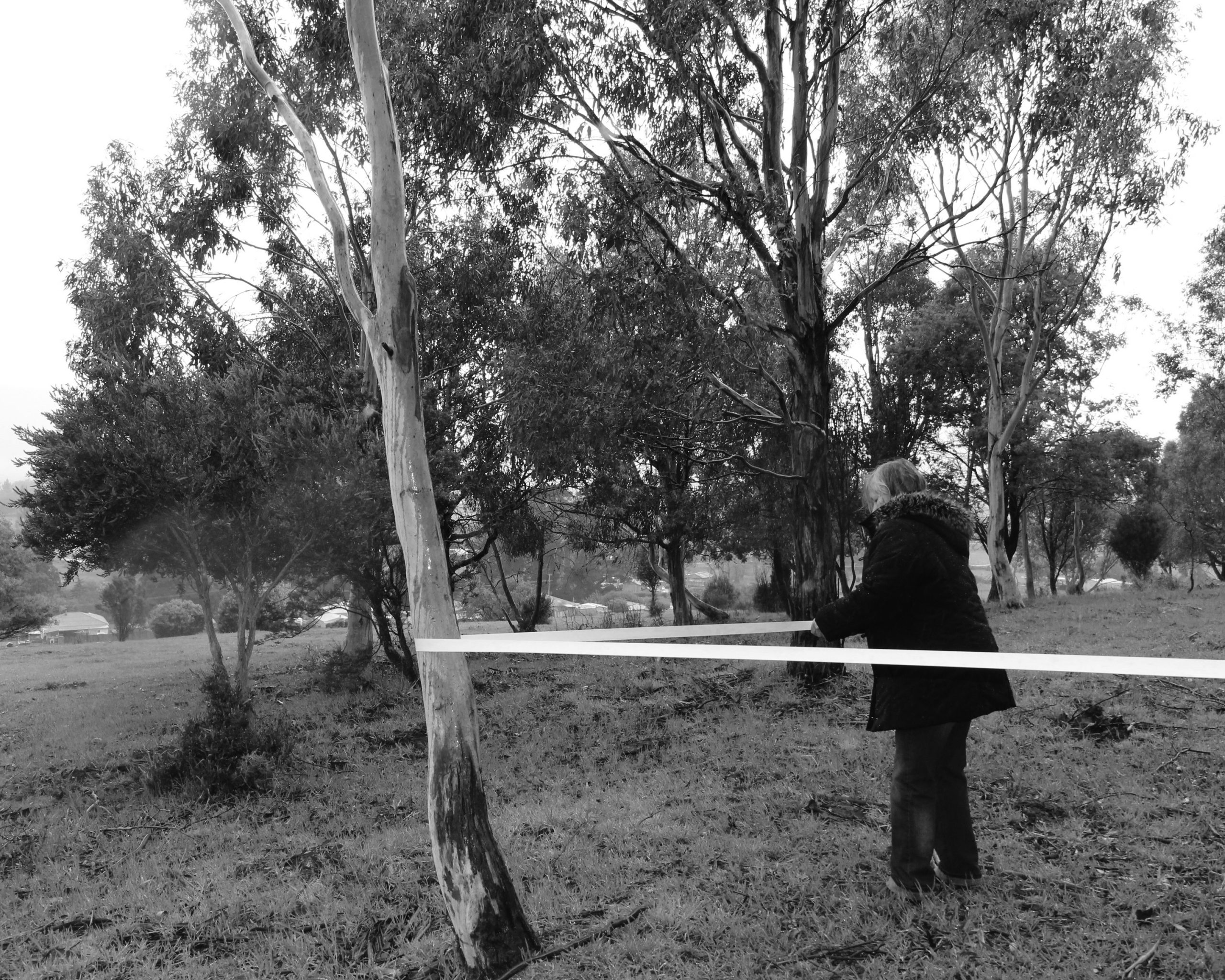
Creating Division with White Lines, Bothwell, Performance Still Image 2016 Copyright Tania Blackwell
This research seeks to present a new landscape memorial typology derived through social exchange and collective encounters. Its curatorial premise draws on the theoretical framework of relational aesthetics.[i]
This Project Anywhere iteration is based in Bothwell, a town located in the central highlands of Tasmania, Australia. The First Tasmanians of this region are the Leenowwenne, Pangerninghe, Braylwunyer, Larmairremener and Luggermairrernerpairrer people of the Big River Nation.[ii]

A Guide to Remembering Book 2019, copyright Tania Blackwell
Through the lens of a 5th generation Tasmanian woman with a colonial convict history linking back to this settled district, the project highlights the lack of recognition of the frontier war that occurred in this region. Earlier research explored what a memorial landscape might look like through an architectural lens for a forgotten war; however, the narrative became much broader and influenced further exploration through the lens of a perpetrator and a thief.
Following the history of the Black Line (1830) and the Black War (1823 – 1831) in Tasmania during colonial invasion[iii], the initial research set out to physically map the region through parallel lines that connected the violence to familial links. Perceptions altered and the deep complexities resonating from the landscape revealed that there were layers of memory, absence and haunting [iv] that was far greater than any one site or place; that culture and Country had been stolen throughout Tasmania through extreme acts of violence and cultural displacement. This then posed the question…how can we capture these memories, this sense of loss and this deep haunting through a colonised concept such as a memorial, a monument, an object or a design?
The act of remembering these atrocities is prompted through a methodology of poetic provocation that aims to disrupt colonial comfort and acknowledge the collective history that took place in this region. Through an assemblage of memory, this Project Anywhere iteration commences with a book which includes earlier site recording and field notes. This book presents a poetic interpretation of loss and remembrance.
The ‘poetic’ is used as a methodology to engage the reader who is taken on a visual journey of images, site installations, poetry and historical text. A small black story book, the reader is drawn in with a sense of familiarity. ‘Provocation’ is also used as a methodology. Provocative narratives of truth and personal nuances are woven in to affront the amnesia.

Mapping Composition of the Military Lines for Quiet Enjoyment, 2016 Copyright Tania Blackwell
The local community are invited to participate; immersing in the narratives of place and the assemblage of memory. The premise is that through participating and engaging in the project and its ‘poetic provocations’ (as a tool for remembering), the experience of memorialisation will embed on a deeper level with those that participate, thus enabling new collective ideas to be generated and captured that will create new work in response. This collective response will include film elements, photographic stills and writing collected through community engagement and exchange during 2020.
It is through participatory practice that knowledge and truth telling will resonate on a far deeper level than a physical memorial space. This new memorial typology can then transcend beyond time and place, being a Project Anywhere that brings the act of remembering to the forefront of our being.
ABOUT THE ARTIST
Tania Blackwell is a Tasmanian Born, Melbourne based interdisciplinary artist. Tania holds a Bachelor of Arts (Fine Art) with Honours, RMIT University 2002 and a Masters of Landscape Architecture Melbourne University 2018. Intangible cultural heritage, deep time, memory, darkness and haunting in landscapes are recurring themes in her creative practice and research. These narratives are explored through composite mapping, installations, photography, writing and through community participation and exchange. Highlighted achievements include; recipient, Steve Calhoun Research Scholarship 2016; presenter Place of Memory, Intangible Cultural Heritage for ICOMOS, Florence, 2017; and presenter of Trauma-scapes and the Aesthetics of Darkness – Tasmanian Landscapes, Island Dynamics Conference, Svalbard, Norway 2019.
[i] Nicolas Bourriaud, Relational Aesthetics, (Dijon, Les presses du reel, 1998) English Edition 2002.
[ii] Lyndall Ryan, Tasmanian Aborigines, A history since 1803 (Sydney, Allen & Unwin, 2012), 16
[iii] Ibid.
[iv] John Wylie, Landscape, (Oxon UK, Routledge, 2007)




